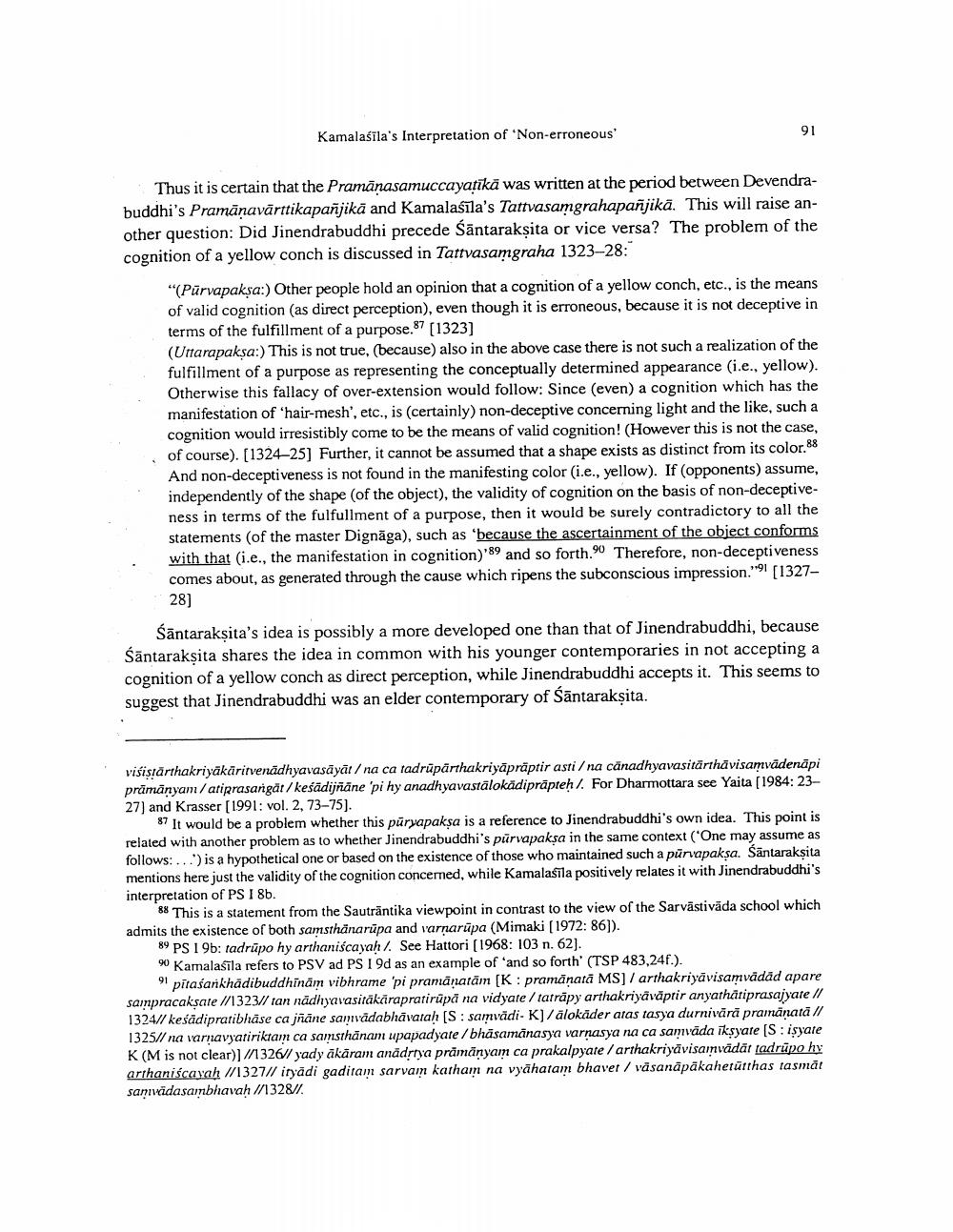________________
Kamalaśīla's Interpretation of 'Non-erroneous'
91
Thus it is certain that the Pramanasamuccayaṭika was written at the period between Devendrabuddhi's Pramāṇavārttikapanjikā and Kamalasila's Tattvasamgrahapañjikā. This will raise another question: Did Jinendrabuddhi precede Säntarakṣita or vice versa? The problem of the cognition of a yellow conch is discussed in Tattvasamgraha 1323-28:
"(Purvapakṣa:) Other people hold an opinion that a cognition of a yellow conch, etc., is the means of valid cognition (as direct perception), even though it is erroneous, because it is not deceptive in terms of the fulfillment of a purpose.87 [1323]
(Uttarapakṣa:) This is not true, (because) also in the above case there is not such a realization of the fulfillment of a purpose as representing the conceptually determined appearance (i.e., yellow). Otherwise this fallacy of over-extension would follow: Since (even) a cognition which has the manifestation of 'hair-mesh', etc., is (certainly) non-deceptive concerning light and the like, such a cognition would irresistibly come to be the means of valid cognition! (However this is not the case, of course). [1324-25] Further, it cannot be assumed that a shape exists as distinct from its color.88 And non-deceptiveness is not found in the manifesting color (i.e., yellow). If (opponents) assume, independently of the shape (of the object), the validity of cognition on the basis of non-deceptiveness in terms of the fulfullment of a purpose, then it would be surely contradictory to all the statements (of the master Dignaga), such as 'because the ascertainment of the object conforms with that (i.e., the manifestation in cognition)'89 and so forth.90 Therefore, non-deceptiveness comes about, as generated through the cause which ripens the subconscious impression."'91 [132728]
Śantarakṣita's idea is possibly a more developed one than that of Jinendrabuddhi, because Śantarakṣita shares the idea in common with his younger contemporaries in not accepting a cognition of a yellow conch as direct perception, while Jinendrabuddhi accepts it. This seems to suggest that Jinendrabuddhi was an elder contemporary of Santarakṣita.
visiṣṭārthakriyäkäritvenādhyavasāyāt/na ca tadrūpārthakriyāpräptir asti/na canadhyavasitarthāvisamvādenāpi prāmāṇyam/atiprasangät/keśādijñāne 'pi hy anadhyavastalokädiprāpteḥ/. For Dharmottara see Yaita [1984: 2327] and Krasser [1991: vol. 2, 73-75].
87 It would be a problem whether this puryapakṣa is a reference to Jinendrabuddhi's own idea. This point is related with another problem as to whether Jinendrabuddhi's purvapakṣa in the same context ('One may assume as follows:...) is a hypothetical one or based on the existence of those who maintained such a purvapakṣa. Šāntarakṣita mentions here just the validity of the cognition concerned, while Kamalasila positively relates it with Jinendrabuddhi's interpretation of PS I 8b.
88 This is a statement from the Sauträntika viewpoint in contrast to the view of the Sarvästivāda school which admits the existence of both samsthänarupa and varṇarupa (Mimaki [1972: 86]).
89 PS 19b: tadrupo hy arthaniścayah. See Hattori [1968: 103 n. 62].
90 Kamalasīla refers to PSV ad PS I 9d as an example of 'and so forth' (TSP 483,24f.).
91 pītaśankhādibuddhīnām vibhrame 'pi pramāṇatām [K: pramāṇatā MS] / arthakriyavisamvädäd apare sampracakṣate //1323// tan nädhyavasitäkärapratirūpä na vidyate / tatrapy arthakriyäväptir anyathātiprasajyate // 1324// keśādipratibhase ca jñāne samvadabhavataḥ [S: samvadi- K]/älokāder atas tasya durnivārā pramäṇatā // 1325//na varnavyatiriktam ca samsthānam upapadyate/bhāsamānasya varṇasya na ca samvada ikṣyate [S: iṣyate K (M is not clear)] //1326// yady akāram anädṛtya pramanyam ca prakalpyate/arthakriyavisamvadāt tadrupo hy arthaniscayah //1327// ityādi gaditam sarvam katham na vyahatam bhavet / väsanäpäkahetutthas tasmāt samvadasambhavaḥ //1328//




